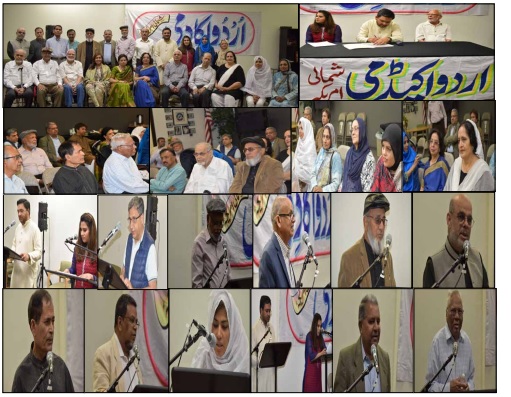Urdu Academy Pays Tributes to Majaz Lakhnawi
By Abdus Sattar Ghazali

The Urdu Academy of North America dedicated its September monthly literary session to the life and work of the legendary Urdu poet Asrar ul Haq Majaz, commonly known as Majaz Lakhnawi. The event was held on September 16, 2018 at the Pakistan American Community Center (PACC), Milpitas, CA.
Mr Zeeshan Abbasi and Mrs Muneeba Zeeshan were the MCs of the literary event. They presented a well-researched maqala on the life and work of Majaz, an eminent poet of Urdu language.
As is customary, a number of Urdu lovers recited the poetry of Majaz Lakhnawi, including Mukeh Kackar, Zafar Yusufzai, Abdus Sattar Ghazali, Mehbook Alam, Moiz Khan, Mobeen Khalil, Mehmoodul Hasan, Erfan Siddiqui, Zeshan Abbasi, Umbareen Wakeel, and Muneba Zeeshan.
Majaz is well known for composing the anthem, tarana, for Aligarh Muslim University, 'Ye meraa chaman, hai mera chaman, Main apne chaman ka bulbul huun.' Mehboob Alam enthralled the audience by presenting this tarana.
Dr Mohammad Ibrahim told the audience that he had vivid recollections of attending a Mushaera at Aligarh in 1952 where Majaz Lakhnawi was a guest poet.
Born as Asrar ul Haq in Rudauli, Faizabad, UP, India on October 19, 1911, Majaz received his early education in Lucknow and at St. John's College, Agra, and obtained a bachelor's degree from Aligarh Muslim University.
Majaz started writing poems while in Aligarh and soon became popular among the masses. He became one of the front-ranking poets of the Taraqqi Pasand Tahreek or Progressive Writers' Movement. Majaz, along with his friends Ali Sardar Jafri and Sibtey Hasan, published the progressive journal ‘Naya Adab’ from Lucknow. It was launched with funds from the CPI in 1939 under the auspices of Urdu Progressive Writers’ Association (UPWA). The journal was the most influential progressive literary monthly of the period and its first three issues actually laid the theoretical foundations of the UPWA movement.
His ghazal 'Tere maathe pe yeh anchal bohot khoob hai/ Lekin tu isse ek parcham bana leti to achchha thaa' was the foremost progressive voice in the 30s.
Majaz lived and wrote in times which were exceptionally vibrant for poetry; poets such as Faiz Ahmed Faiz, Fani Badayuni, Jazbi, Makhdoom and Ali Sardar Jafri were among his peers. They were not merely his contemporaries but closest friends. Others such as Josh and Firaq knew him well. His first diwan, Ahang, is dedicated to Faiz and Jazbi whom he calls his “dil-o-jigar,” and to Sardar Jafri and Makhdoom, who are “mere dast-o-bazu.” Faiz wrote a thoughtful preface to Ahang.
Majaz’s flair for writing Urdu poetry became apparent when he befriended two poets, Fani Badayuni and Jazbi. They were his classmates at St John’s College, Agra in 1929-1931. The years were productive for poetry but everything else for Majaz went awry. He failed his exams badly and acquired bad habits that stayed with him for the rest of his life. Worried about his academic performance, his father got him admission at Aligarh University where he switched from the science stream to arts.
The years at Aligarh were the best, most productive ones for Majaz. Even though he failed in exams, he charmed everyone with his poetry and was made the editor of the prestigious Aligarh University magazine. He composed many of his famous poems there, including the spirited, sparkling, “Nazr-e Aligarh” (composed 1935/36), which was subsequently set to music and has been the tarana or the official song of Aligarh University ever since.
Majaz’s popularity overshadowed all his contemporaries at AMU, including poets such as Ali Sardar Jafri, Jaan Nisar Akhtar and Jazbi. He finished his graduation at AMU in 1936. The same year Professor Ahmed Shah Bukhari, popularly known as ‘Pitras’ Bukhari, calls Majaz to Delhi. Bukhari made him join the newly formed All India Radio as editor of a journal. Majaz named it ‘Awaaz’ and managed it for a while. Their relationship soured for some reasons and Majaz left the station.
Majaz was madly in love with a woman. She married another man which he could not come to terms with. His poetry was greatly influenced by her. He remained unmarried all his life. He became a compulsive drinker. Majaz’s personal grief merged with his rebel ideas. The result was ‘Awara’ – a masterpiece of the era.
“She’her ki raat aur maiN naashaad-o-nakaara phiruN
Jagmagaati jaagti sarkoN pe awara phiruuN
Ghair ki basti hai kab tak dar badar maara phiruN
Aye gham-e-dil kya karooN aye wehshat-e-dil kya karuN”
By the early 1950s, Majaz’s mental faculties started failing. After the partition of India, conditions deteriorated for Majaz and with the help of Josh Malihabadi, Majaz was sent to the mental hospital of Ranchi.
Majaz, a heavy drinker, died alone in a tavern located in the Beldari Lane of Lalbagh, on the cold winter night of December 5,1955 in the heart of the city of Lucknow. He was buried in Nishatgunj graveyard, Lucknow.
On March 28, 2008 Indian Postal Service released a postage stamp to pay homage to the legendary poet, Majaz.
-----------------------------------------------------------------------------

